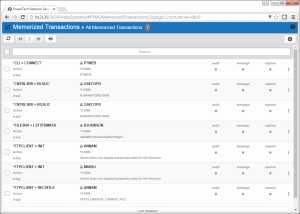The Memorized Transactions screen enables you to maintain memorized transactions. To create a Memorized Transaction, you can select the Memorize button on the View Transaction screen.
How to get there
Click the Memorized Transactions tab on the navigation pane on the left side of the Insite window.
Options
Selection, sorting, filtering, deleting, and navigation features on this screen are described in Using the Web Browser Interface.
Click a memorized transaction to open the Edit Memorized Transaction screen where you can view and edit a memorized transaction.
Field Descriptions
Server > Function
A Server in Network Security is a controlled entry point into your system. These entry points are determined and defined by IBM. Network Security has assigned easy-to-remember names to these controlled entry points.
A Function, or Server Function, in Network Security represents a class of operations that a given Server may perform. For example, the *SIGNON Server classifies its operations as those pertaining to changing passwords, generating authentication tokens, and retrieving sign-on information. Network Security has assigned easy-to-remember names to these Functions, such as CHGPWD, GENAUTTKN and RETRIEVE.
User /Location
User represents the identity of the person initiating a transaction as a user profile. The special value *PUBLIC, when used on a rule, means that the rule applies to any User lacking a specific rule. when used as a subset or selection parameter, *PUBLIC means to select all such rules for display or printing. This displays the User to which this Memorized Transaction applies. If blank, then this is for a specific Location. If the value is *PUBLIC, the transaction applies to all users.
Location represents the source of a transaction. Location can hold an IP Address, an IP Address Group or the name of an SNA Communications Device. The special value *ALL, when used on a rule, means that the rule applies to any rule means that the rule applies to any Location lacking a specific rule. when used as a subset or selection parameter, *ALL generally means to select all such rules for display or printing. This displays the Location to which this Memorized Transaction applies. If blank, then this is for a specific User. If the value is *ALL, the transaction applies to all Users.
Status
This is the status of the Memorized Transaction. Possible values are:
*ACTIVE Network Security will attempt to match this transaction during rule enforcement. Memorized Transactions that are changed to *ACTIVE will have a matching User or Location rule changed to the corresponding action; *ALLOW to *MEMOS400, *REJECT to *MEMREJECT, or *SWITCH to *MEMSWITCH.
*INACTIVE Network Security will not attempt to match this transaction during rule enforcement. Memorized Transactions that are changed to *INACTIVE will have the matching User or Location rule changed (if there are no other Memorized Transactions for that rule) to the corresponding action; *MEMOS400 to *ALLOW, *MEMREJECT to *REJECT, or *MEMSWITCH to *SWITCH.
Authority
Authority represents the action to be taken when a rule is found that matches the data present on a transaction. This field may hold one of these values:
